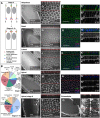Subcellular localisations of the CPTI collection of YFP-tagged proteins in Drosophila embryos
- PMID: 25294944
- PMCID: PMC4197698
- DOI: 10.1242/dev.111310
Subcellular localisations of the CPTI collection of YFP-tagged proteins in Drosophila embryos
Abstract
A key challenge in the post-genomic area is to identify the function of the genes discovered, with many still uncharacterised in all metazoans. A first step is transcription pattern characterisation, for which we now have near whole-genome coverage in Drosophila. However, we have much more limited information about the expression and subcellular localisation of the corresponding proteins. The Cambridge Protein Trap Consortium generated, via piggyBac transposition, over 600 novel YFP-trap proteins tagging just under 400 Drosophila loci. Here, we characterise the subcellular localisations and expression patterns of these insertions, called the CPTI lines, in Drosophila embryos. We have systematically analysed subcellular localisations at cellularisation (stage 5) and recorded expression patterns at stage 5, at mid-embryogenesis (stage 11) and at late embryogenesis (stages 15-17). At stage 5, 31% of the nuclear lines (41) and 26% of the cytoplasmic lines (67) show discrete localisations that provide clues on the function of the protein and markers for organelles or regions, including nucleoli, the nuclear envelope, nuclear speckles, centrosomes, mitochondria, the endoplasmic reticulum, Golgi, lysosomes and peroxisomes. We characterised the membranous/cortical lines (102) throughout stage 5 to 10 during epithelial morphogenesis, documenting their apico-basal position and identifying those secreted in the extracellular space. We identified the tricellular vertices as a specialized membrane domain marked by the integral membrane protein Sidekick. Finally, we categorised the localisation of the membranous/cortical proteins during cytokinesis.
Keywords: Epithelium; GFP; Morphogenesis; Protein trap.
© 2014. Published by The Company of Biologists Ltd.
Figures






References
Publication types
MeSH terms
Substances
Grants and funding
LinkOut - more resources
Full Text Sources
Other Literature Sources
Molecular Biology Databases
Research Materials

